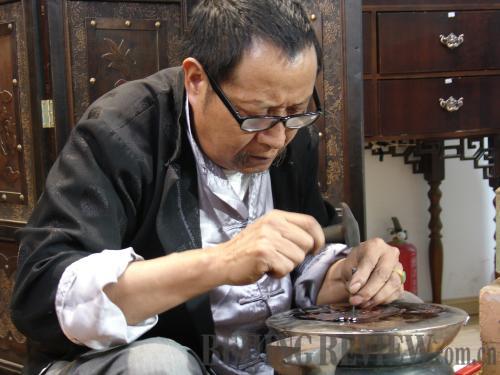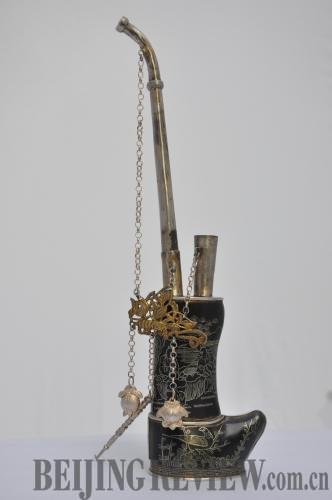| Wutong zouyin, also known as Yunnan bronze ware, is a technique used to make vases and decorations in south China's Yunnan Province. The bronze roughcast is engraved with elaborate patterns before adding molten silver or gold. After the sculpture cools, the brighter inlaid metals contrast spectacularly with the darker bronze. In 2011, the inlaying technique was listed in China's third batch of intangible cultural heritages.
 |
|
Jin Yongcai, the sixth generation inheritor of the Yunnan bronze ware |
Sculptor Jin Yongcai, head of the Wutong Zouyin Studio in Kunming, capital of Yunnan, is the sixth-generation inheritor of the inlaying technique.
"I was only a craftsman casting silver ornaments in the beginning," the 60-year-old told Beijing Review. His pursuit of the craft began when he was 18 years old, after a coincidental opportunity put him on the path to mastery of the 280-year-old endangered technology.
The long heritage road
The material used is black bronze, formed by a process wherein silver or gold are mingled with high-quality copper in accordance with a prescribed practice. Craftsmen will carve intricate patterns on the black bronze, and then apply silver or gold along the carvings. High temperature and chemical methods will be used to make the silver or gold integrate with the copper. The bronze, after cooling down, burnishing and polishing, will turn black, but the silver or gold pattern will appear clearly, yielding black-white or black-yellow effects.
Handicraft works of the black bronze, or the Yunnan bronze ware, include vases, incense burners, and tea utensils, often featuring classic designs.
 |
|
A flagon made of the black bronze has an image of good fortune engraved on it |
The technology came from an inspiration of a craftsman named Yue Fu around 1722-1735 during the reign of the Emperor Yongzheng period in the Qing Dynasty (1644-1911), according to Zhang Yi, the attendant of the head of the studio.
One day, Yue's gold finger ring fell into the furnace and melted down immediately when he smelted copper utensils. He was so angry that he took all silver and aluminum metals in sight and threw them into the furnace. Afterwards, he discovered black copper alloy decorated with looming gold and silver lines. He tried to use this kind of bronze to make handicraft works, creating the technology of wutong zouyin, or Yunnan bronze ware with silver ornaments.
Following the technique's invention, Yue began a tradition to pass down the craft only to male offspring.
However, the technique was eventually passed down to sculptor Li Jiaru for the fifth generation of inheritance, as the Yue Family had no qualified heir. Li was honest and had a strong interest in learning the craft, winning trust of Yue Family.
The technique entered its heyday in the early 1900s, when as many as 30 businesses engaged in production and trading of the bronze ware. Many officers of Kuomintang, all the way up to Chiang Kai-shek, then head of Whampoa Military Academy, liked to order bronze ware ornaments as gifts for decorations of soldiers' swords.
Since the eruption of the Anti-Japanese War (1937-45), it became difficult to buy expensive metals, and craftsmen with knowledge of how to make the black bronze died one after another. "Only Li Jiaru was found to be skillful of the technology at the end of 1970s," said Jin Yongcai.
Jin recalled the days of his acquaintance with Li.
Jin was a silver craftsman in 1975 when he was 18, living in Yunnan, which is home to many minority ethnic groups who loved to wear silver jewelry. Girls, especially when married, often wear silver earrings, bracelets, and hairpins.
As both were silver craftsmen, Jin and Li often met at the local market, finding that their homes were only 500 meters away from each other. As time went on, Jin often visited Li and took care of the elderly. In 1982, Li accepted Jin for his disciple. In 1995, Li, over 80, became ill and often was in hospital.
Once, after leaving the hospital, Li handed Jin a written explanation of his technique and demanded him to memorize it in 15 minutes, saying, "I mustn't allow the technology to be lost after I am dead, or else I will offend the country." Li burned the prescription 15 minutes later.
Li passed away in 1996, leaving the craft tradition to be carried on by others.
Accepting disciples
 |
|
A hookah made of black bronze with carved patterns |
Jin made the bronze ware works only in his spare time and then traded them at the local market on weekends, as he had worked in the community for 11 years.
His products were usually bought by buyers from the countries of Japan and Singapore, and also China's Taiwan in the 1980s and 1990s. Jin often met the buyers in tea houses to bargain prices. After the prices set, Jin would go home to fetch the goods.
"There are many collectors of the products overseas, and they would visit me to order the products when they know that I made this," Jin said.
In recent years, as the Central Government has placed more emphasis on intangible cultural heritage, a general survey was conducted to look for people with knowledge of various crafts. Jin then became heritor of the Yunnan bronze ware technique.
| 